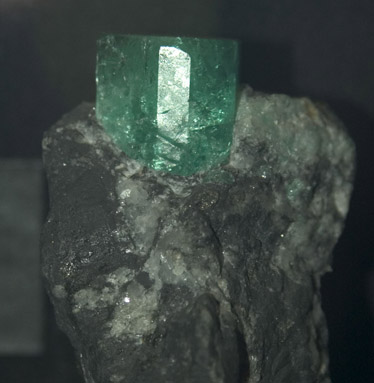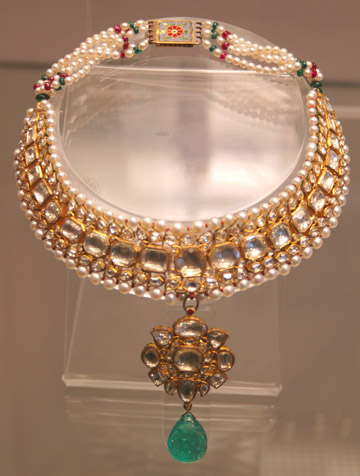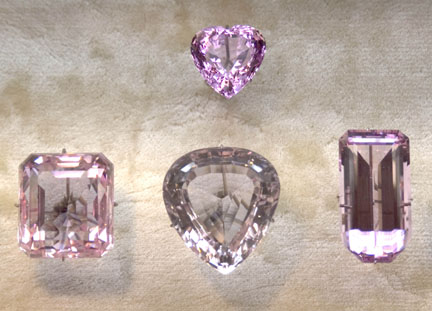
Crystal system: Hexagonal
Chemical Formula/composition:Be3Al2Si6O18
Crystal habit: Hexagonal
Hardness: 7.5-8
Specific gravity: 2.76
Luster: Vitreous - Resinous
Toughness: brittle
Cleavage: None, conchoidal fracture
Optics:
Color: colorless, pale yellowish-green, less
commonly red, orange, yellow, pink, green, blue
Other:
Varieties: Aquamarine, Emerald, Goshenite, Heliodor, Morganite, red beryl, gold beryl (all described below)
Localities: Emerald: Colombia, Brazil, Egypt, Russia. Aquamarine: Many USA localities, Brazil, Russia.
Common simulants: Glass
Synthetics: Many synthetic emerald types are produced by hydrothermal and flux methods.
Beryl is an important gem material with many varieties. These varieities are identified by color and emerald is the most valuable. The mineral beryl is a beryllium aluminosilicate that is colorless in pure form; impurities give beryl its varied coloration. Though beryl has good hardness, it has only average fire and brilliance. Emerald is the green variety and aquamarine, best known as the birthstone for March, is the blue-green variety of beryl. Aquamarine is also a popular gem, though it is not nearly as high in price as emerald.
Emeralds form inside preexisting rocks that are undergoing a geologic process know as metamorphism. The famous Colombian emeralds are found in calcite veins (perhaps marble) that crisscross black shale that has been metamorphosed. The emeralds of Muzo, Colombia are considered the finest in the world. However, the Muzo depsoits are now reported to be exhausted and activity there has ceased. The following picture shows an approximately 1 inch crystal (2.54 cm) in calcite matrix with black shale.

Other colors of beryl include:
The sea-blue variety Aquamarine.
The colorless variety Goshenite.
The greenish-yellow variety Heliodor.
The pink variety Morganite.
red-colored bery is called red beryl
bright golden-yellow beryl is called gold beryl
Emerald is the most valued beryl gemstones and is only rivaled by diamond, ruby,
and sapphire. Its green color is the most desirable green and all other
green gemstones are compared to its intensity. The major colorant is chromium,
and some chrome garnets and tourmaline may come close in color to emerald.
Emerald specimens are often fractured and contain mineral inclusions. These
flaws are so common as to be considered characteristic and help determine
natural from synthetically-produced stones.
This necklace of gold, diamonds, emerald, ruby, and pearls is a Mogol design made in Rajasthan or the Deccan and dating to the 18th or 19th century. This necklace is on display at the Victoria and Albert Museum in London.

Morganite crystals shown below are from the Morgan Memorial Hall of
Gems named after J. P. Morgan who financed a large part of the American
Museum of Natural History's purchase of its mineral and gem collection. 
A collection of beryl crystals of several varieties at the American Museum of Natural History. The largest crystal is about a foot in length
Return to the syllabus main site
Return to the Biological Sciences and
Geology Website